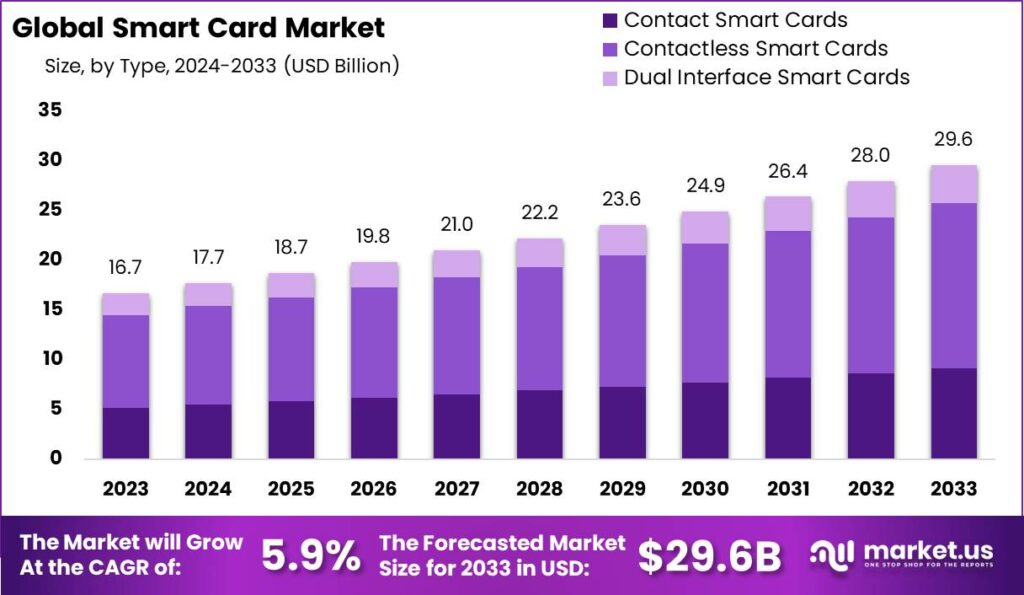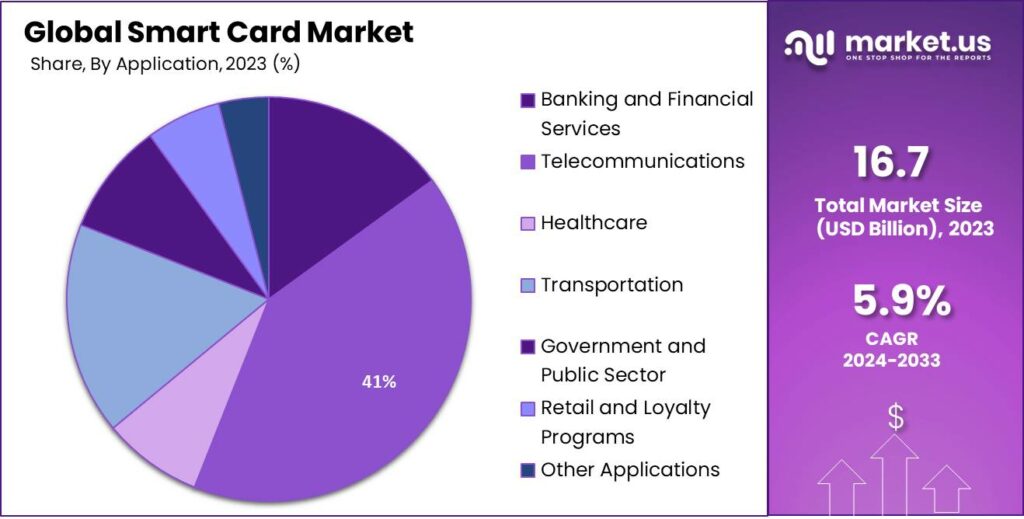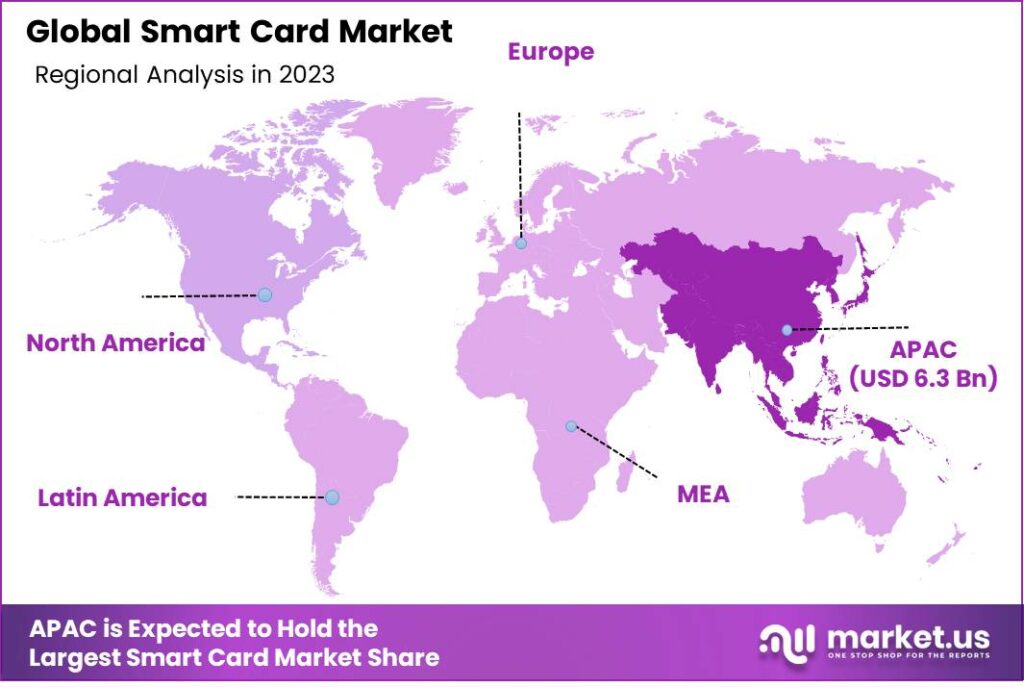New York, Jan. 24, 2024 (GLOBE NEWSWIRE) -- According to Market.us, The Smart Card Market size is expected to be worth around USD 29.6 Billion by 2033, from USD 16.7 Billion in 2023, growing at a CAGR of 5.9% during the forecast period from 2024 to 2033.
A smart card is a portable device embedded with an integrated circuit chip that can securely store and process data. These cards are widely used in various applications, including identification, payment systems, access control, transportation, and healthcare. Smart cards offer enhanced security features compared to traditional magnetic stripe cards, as they can encrypt and protect sensitive information stored on the card.
The smart card market is experiencing substantial growth, driven by increasing adoption across various industries. This market's expansion can be attributed to the growing demand for secure and reliable payment transactions, the rise of mobile phone usage necessitating secure SIM cards, and heightened security concerns leading to widespread adoption in government identification and access control systems. The financial sector, particularly banking and retail, heavily influences market dynamics due to the widespread use of credit and debit cards. Technological advancements, such as the integration of near-field communication (NFC) and biometric technologies, are propelling market growth
Are you a start-up willing to make it big in the business? Grab an exclusive sample of this report here

Analyst Viewpoint
The smart card market is increasingly becoming a critical component across various industries. This trend is a reflection of the evolving technological landscape and the escalating demand for heightened security and efficient data management. The integration of smart cards into sectors like banking, telecommunications, healthcare, and government services underlines their growing importance. The banking sector, in particular, demonstrates a significant reliance on smart cards for secure transactions.
For new market entrants, the scenario presents substantial opportunities. The rising demand for innovative and secure solutions in the smart card industry paves the way for novel product development and market strategies. These entrants can capitalize on niche markets within the smart card ecosystem, such as biometric card development, NFC-enabled cards, or sector-specific smart card applications. The market's trajectory suggests a favorable environment for innovation and competition, particularly for companies that can navigate the challenges of data security and privacy concerns.
Important Revelation:
- The Smart Card Market is expected to reach a substantial value of USD 29.6 billion by the year 2033, with a steady Compound Annual Growth Rate (CAGR) of 5.9% predicted during the forecast period from 2024 to 2033.
- In 2023, the Contactless Smart Cards segment held a dominant market position, capturing more than a 56% share of the global Smart Card Market.
- In 2023, the Telecommunications segment dominated the market, capturing more than 41% share. Smart cards, particularly SIM cards, play a crucial role in mobile communications, subscriber authentication, and network connectivity.
- Asia-Pacific held a dominant market position in 2023, with a 38% share. Rapid technological advancements, high adoption rates in sectors like banking, telecommunications, and government services, along with a growing middle-class population, contributed to this leadership.
Buy Now this Premium Report to Grow your Business: https://market.us/purchase-report/?report_id=19653
Factors Affecting the Growth of the Global Smart Card Market
- Technological Advancements: The rapid development of microprocessor technology and contactless communication methods such as Near Field Communication (NFC) has greatly enhanced the capabilities of smart cards. This technological evolution has expanded their applications in various sectors, including banking, telecommunications, and government services.
- Increased Security Needs: In an era where data breaches and identity theft are prevalent concerns, smart cards offer a higher level of security compared to magnetic stripe cards. Their ability to store and process data securely makes them ideal for applications requiring stringent security measures, such as financial transactions and access control.
- Government Initiatives and Regulations: Governments worldwide are increasingly adopting smart cards for identification, driving licenses, and health care services. This adoption is often part of broader initiatives aimed at enhancing security, reducing fraud, and improving public administration efficiency.
- Growth in Telecommunication Sector: The expansion of the telecommunication sector, particularly in emerging economies, has led to a surge in demand for SIM cards, a specific type of smart card. The proliferation of mobile devices and the transition to higher capacity SIM cards for 4G and 5G networks contribute to this growth.
- Banking Sector Evolution: The banking industry's shift towards digital and cashless transactions has increased the demand for smart cards. EMV (Europay, MasterCard, and Visa) chip technology, in particular, has become a global standard for credit and debit card transactions, offering enhanced security over traditional magnetic stripe cards.
Recent Developments
- In 2023, Samsung Electronics: Focus on secure payment solutions: Launched the S3B464, a highly secure dual-interface smart card chip for contactless payments, leveraging secure element hardware and software to protect financial data.
- In 2023, Sony Corporation: Strengthened presence in NFC payment market: Introduced the FeliCa Lite-S contactless chip, targeting low-cost payments, loyalty programs, and access control applications.
Want to Access the Statistical Data and Graphs, Request PDF Sample @ https://market.us/report/smart-card-market/request-sample/
Competitive Landscape
The competitive landscape of the market has also been examined in this report. Some of the major players include:
- Gemalto (Thales Group)
- Giesecke+Devrient
- IDEMIA
- NXP Semiconductors
- Infineon Technologies
- CPI Card Group
- STMicroelectronics
- HID Global
- Oberthur Technologies (OT-Morpho)
- Samsung Electronics Co., Ltd.
- Sony Corporation
- Other Key Players
Scope of the Report
| Report Attributes | Details |
| Market Value (2023) | US$ 16.7 Billion |
| Forecast Revenue 2033 | US$ 29.6 Billion |
| CAGR (2024 to 2033) | 5.9% |
| Asia-Pacific Revenue Share | 38% |
| Base Year | 2023 |
| Historic Period | 2018 to 2022 |
| Forecast Year | 2024 to 2033 |
Report Segmentation
Type Analysis
In 2023, the Contactless Cards segment held a dominant market position, capturing more than a 56% share of the global smart card market. This dominance can be attributed to several compelling factors. Firstly, contactless cards offer unparalleled convenience and speed in transactions, a feature increasingly valued in the fast-paced consumer environment. The ability to complete transactions with a simple tap significantly enhances user experience, particularly in high-traffic settings like public transport and retail outlets.
Moreover, the COVID-19 pandemic has played a pivotal role in accelerating the adoption of contactless cards. With heightened awareness about hygiene and social distancing, consumers and businesses alike have shown a preference for contactless interactions, thereby boosting demand for these cards.
The banking sector, a major end-user of smart cards, has been rapidly transitioning to contactless technology, driven by mandates from major credit card companies and a push towards digital banking solutions. This shift is evidenced by the increasing issuance of contactless credit and debit cards globally.
Application Analysis
In 2023, the Telecommunications segment held a dominant position in the Smart Card market, capturing more than a 41% share. This prominence can be attributed to several key factors. Firstly, the increasing adoption of mobile devices has escalated the demand for SIM cards, which are a type of smart card. As mobile devices become more integral to daily life, the need for secure and efficient communication solutions is paramount, thereby fueling the growth of this market segment.
Additionally, the evolution of telecommunication standards, such as the transition from 4G to 5G networks, has necessitated the upgrade of existing SIM cards to advanced smart cards capable of supporting these new technologies. This transition not only drives the demand for new smart cards but also enhances the security features essential for modern telecommunications, further solidifying the segment's market position.
Moreover, the telecommunications sector's ongoing focus on improving customer service and operational efficiency has led to the integration of smart card technology in various applications. These include secure access to networks, data encryption, and subscriber authentication. The incorporation of smart cards in these applications ensures a secure and seamless user experience, which is crucial in the highly competitive telecommunications industry.

Buy this Complete Business Report@ https://market.us/purchase-report/?report_id=19653
Key Market Segments
Type
- Contact Smart Cards
- Contactless Smart Cards
- Dual Interface Smart Cards
Application
- Banking and Financial Services
- Telecommunications
- Healthcare
- Transportation
- Government and Public Sector
- Retail and Loyalty Programs
- Other Applications
Driver: Increasing Demand for Secure Transactions
One primary driver of the global smart card market is the escalating demand for secure and reliable transaction methods. This trend is particularly notable in sectors such as banking, healthcare, and government, where smart cards offer enhanced security features like biometric data integration and encryption. These cards are increasingly being used for secure access control, identification, and financial transactions, thus fostering market growth.
Restraint: High Costs of Deployment and Maintenance
A significant restraint facing the smart card market is the high initial costs associated with deploying smart card systems. This includes expenses for card readers, software integration, and maintenance. Smaller organizations and those in emerging economies often find these costs prohibitive. Additionally, the ongoing need for system upgrades and maintenance can further increase the total cost of ownership, deterring potential adopters.
Opportunity: Emergence of Contactless Technology and IoT Integration
The integration of contactless technology and the Internet of Things (IoT) presents a considerable opportunity for the smart card industry. Contactless smart cards, utilizing technologies such as Near-Field Communication (NFC), are gaining traction for their convenience and speed in transactions. Moreover, the integration of smart cards with IoT devices can lead to innovative applications in areas such as smart homes, healthcare monitoring, and secure access to connected devices, potentially opening new markets and applications for smart cards.
Regional Analysis
In 2023, the Asia-Pacific (APAC) region held a dominant market position in the global smart card industry, capturing more than a 38% share. This significant market share can be attributed to the rapid technological advancements and increasing adoption of digital payment methods in countries such as China, Japan, and India. The APAC region is also experiencing a surge in government initiatives aimed at promoting digitalization, further propelling the demand for smart cards in sectors like banking, transportation, and government services.
Meanwhile, North America, driven by a well-established technological infrastructure and high consumer awareness, continues to be a key player in the smart card market. The United States and Canada are at the forefront of implementing advanced security solutions in payment and identification systems, fueling the regional market growth.

By Geography
- North America
- The US
- Canada
- Europe
- Germany
- France
- The UK
- Spain
- Italy
- Russia
- Netherland
- Rest of Europe
- APAC
- China
- Japan
- South Korea
- India
- Australia
- New Zealand
- Singapore
- Thailand
- Vietnam
- Rest of APAC
- Latin America
- Brazil
- Mexico
- Rest of Latin America
- Middle East & Africa
- South Africa
- Saudi Arabia
- UAE
- Rest of MEA
Explore Extensive Ongoing Coverage on Technology and Media Reports Domain:
- Recruitment Marketing Platforms Market is expected to have a share of USD 2,656.9 Million by 2033, at a steady CAGR of 8.4%.
- Banknote Printing Machine Market size is expected to reach USD 36.8 billion by 2033, exhibiting an impressive CAGR of 10.4%.
- EV Charging Connector Market is projected to reach a valuation of USD 358.7 Mn by 2033 at a CAGR of 17.6%, from USD 70.9 Mn in 2023.
- Next Generation Non Volatile Memory Market is anticipated to be USD 37.3 billion by 2033. It is estimated to record a steady CAGR of 22.5%.
- Legal Case Management Software Market is forecasted to exhibit a 13.4% CAGR, reaching a substantial size of USD 5.9 billion by 2033.
- Immersive-Reality Technologies Market size is expected to register USD 780.4 Billion by 2023, anticipated to showcase a steady CAGR of 24%.
- HomeLab Market is anticipated to be USD 8.7 billion by 2033. It is estimated to record a steady CAGR of 6.1%.
- Machine Learning Operations (MLOps) Market is likely to attain a valuation of USD 75.42 Billion by 2033, Develop at a CAGR of 2.60%.
- Generative ai in media and entertainment Market is likely to attain a valuation of USD 11,570.0 million by 2032, develop at a CAGR of 26.3%
- Location-based Ambient Intelligence Market size is anticipated to reach a valuation of USD 1239.3 Bn by 2032; At a robust CAGR of 21.4%.
- System Integration Services Industry is predicted to expand at a CAGR of 9.9% from 2023 to 2032, reaching USD 1,006.0 billion by 2032.
- Power Sockets Market is predicted to expand from USD 5,586.2 billion in 2023 to USD 8,850.8 billion by 2032; CAGR of 5.4%.
- Digital Avatar Market is projected to expand to USD 533.8 Billion by 2032. The market is estimated to experience a CAGR of 45.8%.
- Hybrid workplace market was valued at USD 4.9 Billion in 2023 and is expected to reach USD 21.1 Billion by 2032, At a CAGR of 18.3%.
- Artificial Intelligence in Food and Beverage Market is poised to reach USD 311.6 Bn by 2033, growing at a CAGR of 43.7% from 2024-2033.
- AI-Powered Video Editing Software Market is Poised to Attain USD 1,032 Million by 2032 with a 6.3% CAGR, Fueled by E-Learning Sectors.
- Industry 4.0 market size is expected to be worth around USD 482 billion by 2032 from USD 93 billion in 2023; CAGR of 20.7%
- Customer Care BPO Market Poised to Attain USD 43,096.6 Million by 2032 From USD 25,459.3 Million with Growing CAGR of 6.2%.
About Us
Market.US (Powered by Prudour Pvt Ltd) specializes in in-depth market research and analysis and has been proving its mettle as a consulting and customized market research company, apart from being a much sought-after syndicated market research report-providing firm. Market.US provides customization to suit any specific or unique requirement and tailor-makes reports as per request. We go beyond boundaries to take analytics, analysis, study, and outlook to newer heights and broader horizons.
Follow Us On LinkedIn Facebook Twitter
Our Blog:
